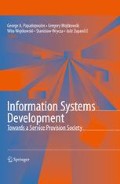Abstract
This chapter describes ongoing action research which is exploring the use of BPMN and a specific toolset – Intalio Designer to capture the “as is” essential process model of part of an overarching large business process within higher education. The chapter contends that understanding the efficacy of the BPMN notation and the notational elements to use is not enough. Instead, the effectiveness of a notation is determined by the notation, the toolset that is being used, and methodological consideration. The chapter presents some of the challenges that are faced in attempting to develop computation independent models in BPMN using toolsets such as Intalio Designer™.
Access this chapter
Tax calculation will be finalised at checkout
Purchases are for personal use only
References
Andrews, T., Curbera, F., Dholakia, H., Goland, Y., Klein, J., Leymann, F., Liu, K., Roller, D., Smith, D., Thatte, S., Trickovic, I., and Weerawarana, S. (2003). Business Process Execution Language for Web Services. Version 1.1. BEA Systems, International Business Machines Corporation, Microsoft Corporation, SAP AG and Siebel Systems, available at: http://xml.coverpages.org/BPELv11-May052003Final.pdf
Barn, B.S., Dexter, H., Oussena, S., and Petch, J. (2006). An Approach to Creating Reference Models for SOA from Multiple Processes. In: IADIS Conference on Applied Computing, Spain.
BPM. (2005). http://www.omg.org/news/releases/pr2005/06-29-05.htm
BPMI.org. (2006). OMG: Business Process Modeling Notation Specification. Final Adopted Specification. Object Management Group, available at: http://www.bpmn.org
Bunge, M. (1997) Treatise on Basic Philosophy, Volume 3: Ontology I: The Furniture of the World, Boston: Reidel.
Davenport, T. and Short, J. (1990). The New Industrial Engineering: Information Technology and Business Process Redesign. Sloan Management Review, 31(4), 11–27.
Erl, T. (2005). Service Oriented Architecture – Concepts, Technology and Design, Englewood Cliffs, NJ: Prentice-Hall.
Frankel, D. (2004). Model Driven Architecture, Needham, MA: OMG Press
Frankel, D. (2005). Business Process Trends. BPTrends http://www.bptrends.com/publicationfiles/07%2D05%20COL%20BP%20Platform%20%2D%20Frankel%2Epdf
Hammer, M. (1990). Reengineering Work: Don’t Automate, Obliterate. Harvard Business Review, 68(4), 104–112.
Hammer, M. and Champy, J. (1993). Reengineering the Corporation, A Manifesto for Business Revolution, London: Nicholas Brealey.
Huang, J.C., Newell, S., Poulson, B., and Galliers, R.D. (2005). Deriving Value from a Commodity Process: A Case Study of the Strategic Planning and Management of a Call Center. In: Proceedings of the Thirteenth European Conference on Information Systems (Bartmann, D., Rajola, F., Kallinikos, J.,Avison, D., Winter, R., Ein-Dor, P., Becker, J., Bodendorf, F., and Weinhardt, C., eds.), Regensburg, Germany.
Knutilla, A., Schlenoff, C., Ray, S., Ployak, S.T., Tate, A., Cheah, S.C., and Anderson, R.C. (1998). Process Specification Language: An Analysis of Existing Representations, National Institute of Standards and Technology (NIST), Gaithersburg (MD), NISTIT 6160
Lau, F. (1997). A Review on the Use of Action Research in Information Systems Studies. In: Information Systems and Qualitative Research (Lee, A.S., Liebenau, J., and DeGRoss, J.I., eds.), Berlin: Springer.
Ort, E. (2005). Service-Oriented Architecture and Web Services: Concepts, Technologies, and Tools. http://java.sun.com/developer/technicalArticles/WebServices/soa2/
Ould, M. (1997). Designing a Re-engineering-proof Process Architecture. Business Process Management Journal, 3(3).
Oussena, S. and Barn, B. (2007). Applying Component Concepts to Service Oriented Design: A Case Study. Conference: Presented at 2nd International Conference on Software and Data Technologies (ICSOFT 2007) 22–25 July 2007 Barcelona, Spain.
QAA: http://www.qaa.ac.uk/
Recker, J., Indulska, M., Rosemann, M., and Green, P. (2006). How Good is BPMN Really? Insights from Theory and Practice. In: Proceedings of the 14th European Conference on Information Systems. Association for Information Systems (Ljungberg, J. and Andersson, M., eds.), Goeteborg, Sweden, 1582–1593.
Sedera W., Rosemann M., and Doebeli, G. (2003). A process modelling success model: insights from a case study. In: Proceedings of the Eleventh European Conference on Information Systems (Ciborra, C.U., Mercurio, R., de Marco, M., Martinez, M., and Carignani, A., eds.), Naples, Italy.
Smith, H. and Fingar, P. (2003). Business Process Management: The Third Wave, Tampa, FL: Meghan-Kiffer Press.
UCAS: http://www.ucas.ac.uk/
Vidgen, R. and Wang, X. (2006). From Business Process Management to Business Process Ecosystem. Journal of Information Technology, 21, 262–271.
Wand, Y. and Weber, R. (1995). On the Deep Structure of Information Systems. Information Systems Journal, 5(3), 203–223.
Zur Muehlen, M., and Ho, D.T. (2008). Service Process Innovation: A Case Study of BPMN in Practice. In: Proceedings of the 41st Hawaii International Conference on System Sciences.
Zur Muehlen, M. and Recker, J. C. (2008). How Much Language is Enough? Theoretical and Practical Use of the Business Process Modeling Notation. In: Proceedings 20th International Conference on Advanced Information Systems Engineering, Montpellier, France.
Acknowledgements
This work has been supported by funding from JISC – Joint Information Systems Committee http://www.jisc.ac.uk. For further details of the COVARM and COVa projects see: http://covarm.tvu.ac.uk/covarm and http://samsa.tvu.ac.uk/cova
Author information
Authors and Affiliations
Editor information
Editors and Affiliations
Rights and permissions
Copyright information
© 2009 Springer Science+Business Media, LLC
About this chapter
Cite this chapter
Barn, B.S., Oussena, S. (2009). BPMN, Toolsets, and Methodology: A Case Study of Business Process Management in Higher Education. In: Papadopoulos, G., Wojtkowski, W., Wojtkowski, G., Wrycza, S., Zupancic, J. (eds) Information Systems Development. Springer, Boston, MA. https://doi.org/10.1007/b137171_71
Download citation
DOI: https://doi.org/10.1007/b137171_71
Published:
Publisher Name: Springer, Boston, MA
Print ISBN: 978-0-387-84809-9
Online ISBN: 978-0-387-84810-5
eBook Packages: Computer ScienceComputer Science (R0)

